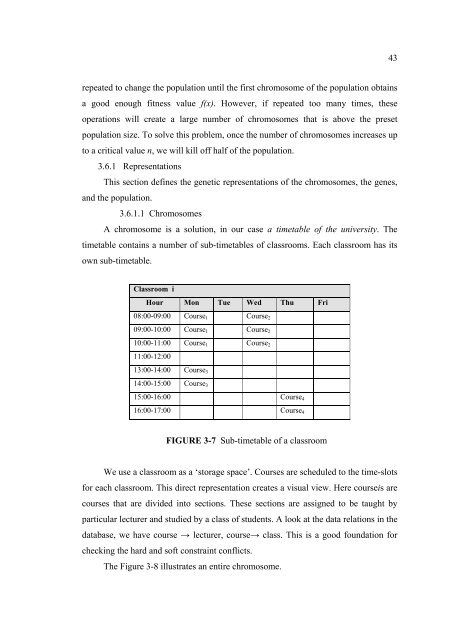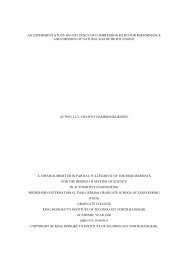a multi-objective bisexual reproduction genetic algorithm for ...
a multi-objective bisexual reproduction genetic algorithm for ...
a multi-objective bisexual reproduction genetic algorithm for ...
You also want an ePaper? Increase the reach of your titles
YUMPU automatically turns print PDFs into web optimized ePapers that Google loves.
43<br />
repeated to change the population until the first chromosome of the population obtains<br />
a good enough fitness value f(x). However, if repeated too many times, these<br />
operations will create a large number of chromosomes that is above the preset<br />
population size. To solve this problem, once the number of chromosomes increases up<br />
to a critical value n, we will kill off half of the population.<br />
3.6.1 Representations<br />
This section defines the <strong>genetic</strong> representations of the chromosomes, the genes,<br />
and the population.<br />
3.6.1.1 Chromosomes<br />
A chromosome is a solution, in our case a timetable of the university. The<br />
timetable contains a number of sub-timetables of classrooms. Each classroom has its<br />
own sub-timetable.<br />
Classroom i<br />
Hour Mon Tue Wed Thu Fri<br />
08:00-09:00 Course 1 Course 2<br />
09:00-10:00 Course 1 Course 2<br />
10:00-11:00 Course 1 Course 2<br />
11:00-12:00<br />
13:00-14:00 Course 3<br />
14:00-15:00 Course 3<br />
15:00-16:00 Course 4<br />
16:00-17:00 Course 4<br />
FIGURE 3-7 Sub-timetable of a classroom<br />
We use a classroom as a ‘storage space’. Courses are scheduled to the time-slots<br />
<strong>for</strong> each classroom. This direct representation creates a visual view. Here courseis are<br />
courses that are divided into sections. These sections are assigned to be taught by<br />
particular lecturer and studied by a class of students. A look at the data relations in the<br />
database, we have course → lecturer, course→ class. This is a good foundation <strong>for</strong><br />
checking the hard and soft constraint conflicts.<br />
The Figure 3-8 illustrates an entire chromosome.













